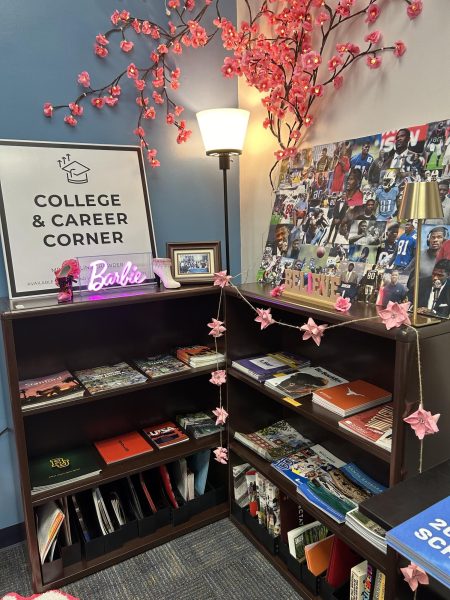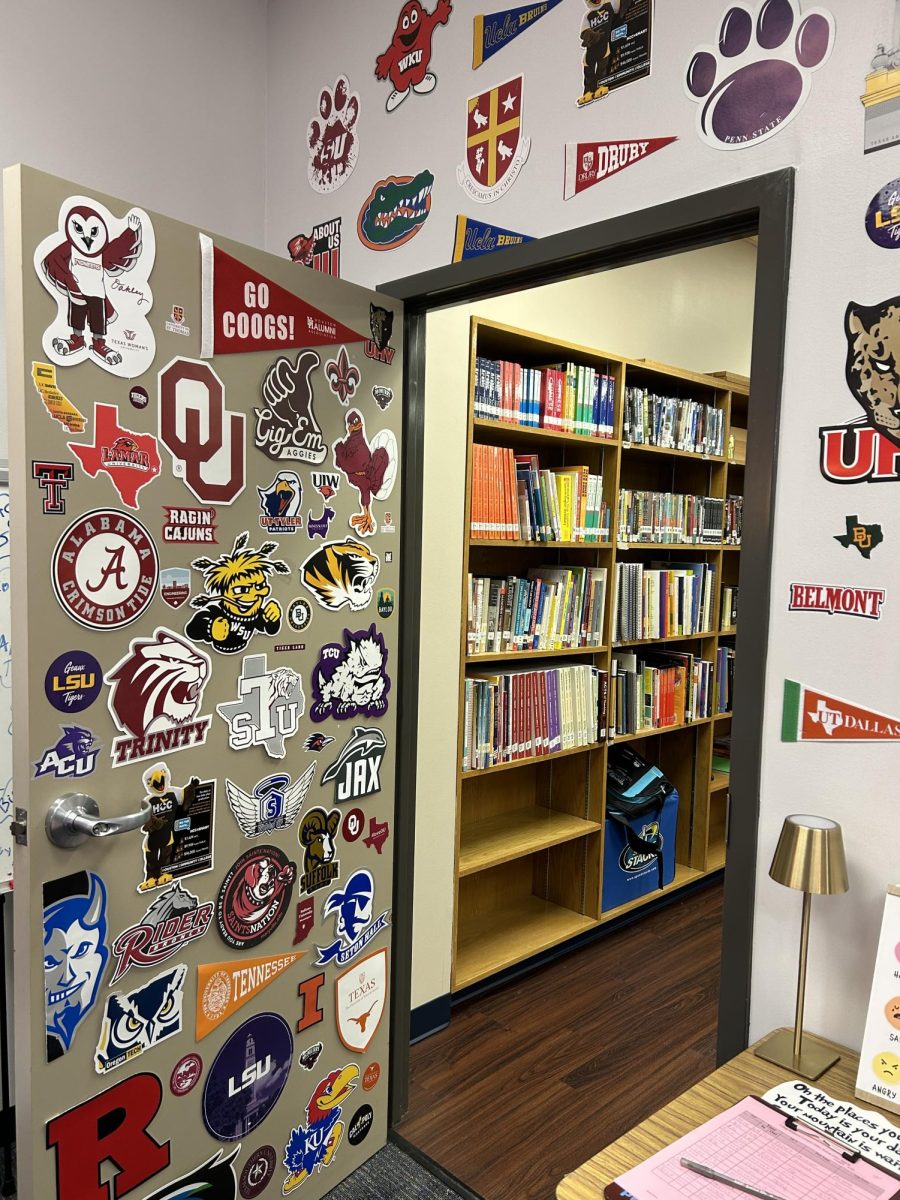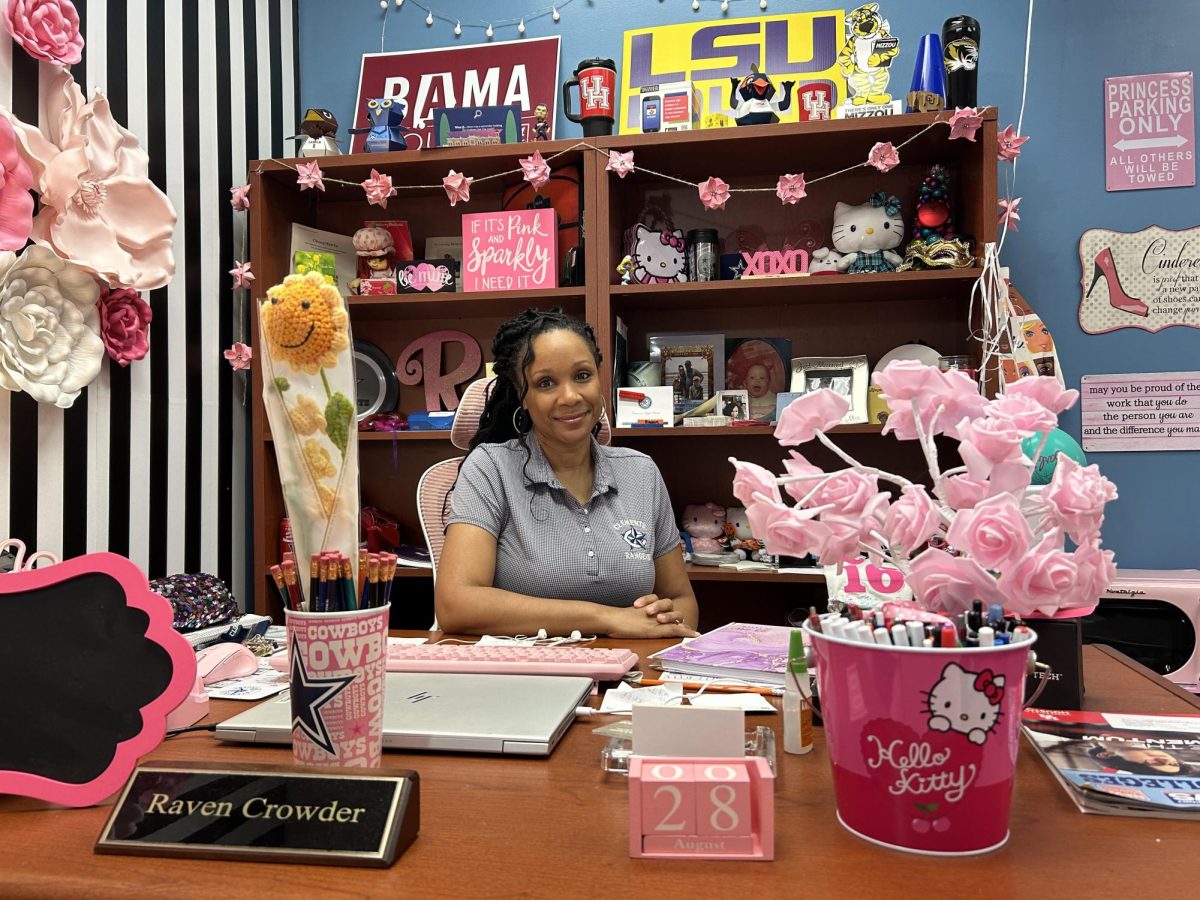This piece is the second in a News series with college and career advisor Raven Hollins-Crowder regarding seniors’ college application period. If you are looking for a preview of what will be discussed, read this.
A Q&A with Hollins-Crowder including more information on what colleges are looking and advice on essays will go live later this week. It can be found in the college application series, which can be viewed here.
In an attempt to clear away any dark clouds of confusion in seniors’ minds, college and career advisor Raven Hollins-Crowder is stopping by senior-level English classes all throughout the week to explain the logistics behind the college application process.
To broadly recap the sessions, Hollins-Crowder mainly discussed counselor and teacher recommendation letters, differences in ApplyTexas and CommonApp on how to send transcripts, alumni access, what test optional means, how to file for FAFSA and more. Most importantly, Hollins-Crowder discussed the different roles of the holy trinity: SchooLinks, CommonApp and ApplyTexas, and the role each of them plays in the college application process.
“No actual applications are done in SchooLinks,” Crowder said. “They’re done with the CommonApp. Then [there’s also] Apply Texas or the direct institution that your university may have for their application. SchooLinks still says College Applications, [but] I like to call it a communication tool. It is how you, the student, communicates with Clements of where you plan to apply. And in turn, this is how Clements communicates with the universities about getting your paperwork there.”
The student’s role in the paperwork—which encompasses your transcript, the school report and the school profile—encounters a figurative fork in the road divided by students’ platform of choice, though both ultimately lead to the same destination, the college. The difference lies in the office that manages the paperwork. ApplyTexas institutions are all handled solely by the registrar’s office, whereas for CommonApp, which is handled by your Alpha Split counselor, there is an additional step for students.
“You must let your counselor know that you’ve applied to universities using CommonApp,” Hollins-Crowder said. “And the way you do that is by using their jot form that can be found in the counselor’s Schoology group [or] on the counselor’s page [on the Clements Homepage].”
The jot form is also responsible for counselors’ “beautiful” letter of recommendations, Hollins-Crowder said, even if students aren’t very familiar with their respective counselors.
“That’s where you tell your counselor a little bit about yourself [and] get some kind of feedback from teachers that’s going to go directly to the counselor, so that way they can talk about the amazing things that you’ve done in the school, in the classroom, what you like to do, things of that nature,” Hollins-Crowder said. “So that way the counselor doesn’t have to say something like, yes, so-and-so goes to Clements and they graduate in May. That’s not the kind of rough letter that anyone wants to write.”
Hollins-Crowder also shared her two cents worth on asking teachers about writing your recommendation letters.
“Do not let the first time your teacher find out that you want a rec letter be through SchooLinks,” Hollins-Crowder said. “Please have a conversation in person first. That should be the first thing you do…‘Please’ and ‘thank you’ goes very far, and then you can make the request via SchooLinks.”
Once the teacher has agreed to write the letter, Hollins-Crowder recommends that students hold off on adding the teacher as a recommender until the rest of the application is nearing completion. The same applies to the counselor’s jot form.
“Even though there’s no right or wrong order in doing your college application, [colleges have a] preference,” Hollins-Crowder said. “Once you are rather far along on that application, that is when you will want to start [asking for recommendation letters]. You don’t want your recommendation to beat your application.”
Students are also able to list one teacher as the recommender for multiple schools, which will be done individually during each college’s application process through SchooLinks. The teacher can then use the same recommendation letter for all of the selected colleges. The process is slightly different if students are requesting for a recommendation letter outside of the school district, since their names will not show on SchooLinks.
“You have to make that request directly from CommonApp and list them as an other recommender, even if they were your teacher and they no longer are, you will still list them as other recommender,” Hollins-Crowder said. “When the university receives the rec letter, they will very well see that it is someone that was the teacher for you in the past.”
Other abnormalities include if a college requires mailed letter of recommendations—for this, students will give a self-addressed and stamped envelope to the recommender, who will then put the letter inside, seal the envelope and drop it in the mail—or if a student is applying through ApplyTexas, which doesn’t necessarily require recommendation letters as part of the application process.
“We’re going to go through a scenario,” Hollins-Crowder said. “You [have applied] to Sam Houston State University, and you have confirmation that they received your application, and they send you your temporary credentials to log in and create your Sam Houston portal. Once you do that, many universities will then give you that option to send your request from your portal with that individual university.”

Another major part of the application process, sometimes optional depending on the college, are standardized test scores and class rank. Hollins-Crowder advises first-time SchooLinks visitors to really think about whether they want colleges to see their rank or not, because once the selection is made, it’s final.
“I really hope none of you got super excited in July and was like, ‘Yes, I’m going to click on this,’ because you cannot change your mind,” Hollins-Crowder said. “[Regarding] if you want to share your rank or not, I do not give suggestions on that…same thing with scores.”
To make a more informed decision, Hollins-Crowder recommends that students look at their university’s profile of their current freshman class.
“It will tell you approximately how many were in the top, whatever magic number,” Hollins-Crowder said. “And then it will also tell you what the median score was for their SAT. It will break it down by ELA and math. Same thing with ACT.”
But there are also additional steps to the admissions that isn’t listed in SchooLinks, CommonApp or ApplyTexas. These sometimes fly under the radar but are vital to being officially recognizing as an undergraduate student. One is to maintain alumni access to SchooLinks, which is how students will send their final year transcript to the admissions’ office over the summer.
“Every year, we have Rangers reaching out in a panic because they cannot request the transcripts,” Hollins-Crowder said. “And it’s always around July, because that’s when orientations start happening. Universities are letting students know, ‘We don’t have your final transcripts. Please do not show up unless that final transcript is in.’ In a normal circumstance, that would be okay. But in July, Ms. Crowder is still at home and I’m not checking email. So I can’t go ahead and update everything for you.”
To “cut the middleman” in the mentioned scenario, students can simply go into their SchooLinks settings and add their personal email address, Hollins-Crowder said. The other important post-application step is to file for Free Application for Federal Student Aid (FAFSA).
“Think of that as the gateway to all federal funding,” Hollins-Crowder said. “So, that’s the guaranteed loans, that’s the Pell Grant, that is money for college that you, the student, will apply for. They still need parent information as well. The FAFSA opens October 1st. So, generally, what we tell students is to, in advance, set up your FSA account.”
Even if students don’t believe they are going to receive “free money”, Hollins-Crowder recommends setting up the profile anyway because when merit money is handed out, colleges like to see that the student is exhausting all other funding-related possibilities.
“Every year in May, I am chasing students around because they still have not either done a FAFSA, TASFA, or completed an opt-out form,” Hollins-Crowder said. “It is super, super easy, guys. When I had to do the FAFSA, it was on paper and there were 116 questions. It’s now 38 questions and it’s online for you all. Very, very good difference. I used to have to mail it off. It took six to eight weeks to get a response. You all will get a response [instantly].”
From there, the last step is for students to report their status via SchooLinks under the college financing tab. For any additional questions, Hollins-Crowder welcomes students to visit her room in the back of the library.
“Students can come in during the day, before school, during lunch,” Hollins-Crowder said. “A lot of seniors may have an off period or if they have office aid or if they get a pass from their teacher, they absolutely are welcome to come in. The only exception to that would be if I’m meeting with the college admissions rep or if I have a college rep visit taking place then I’m not able to see students, but if I’m in my office and I’m available, I will see a student.”



